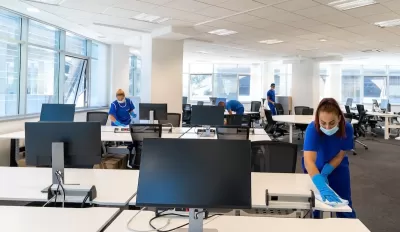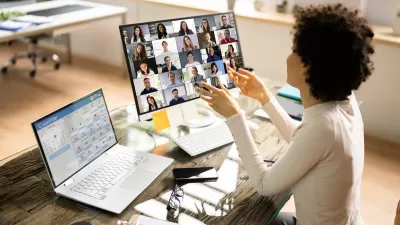The number of Americans who work from home rose sharply during the pandemic and remains high, posing important questions about the future of transportation and housing.

In a piece for Bloomberg CityLab, David Zipper outlines key ways that the rapid shift to remote work during and after the Covid-19 pandemic has altered U.S. cities.
Transit ridership has dropped and rush-hour gridlock has softened, while mid-day traffic has grown. Population patterns shifted as “Zoom towns” outside of major cities swelled with digital nomads who abandoned big-city business districts where highways and transit lines historically converge.
While some companies are taking a stricter stance on returning to the office, many workers are happy to keep working from home, making downtown offices largely obsolete. According to researcher Patricia Mokhtarian, who predicts that the remote work rate will continue to hover around 15 percent of U.S. workers, Covid has had a much longer-lasting impact on telework than prior disruptive events she’s studied, in part because new technologies allow more people to effectively do their jobs from outside the office.
Mokhtarian notes that while remote work can reduce vehicle miles traveled (VMT), its impacts on transit and air travel are less clear. “[I]t’s possible that people working from home are moving further outside the city. That can reduce transit use, and they might buy bigger homes that have more embedded carbon and require more energy to heat and cool.”
FULL STORY: Will Americans Ever Lose Their Taste for Telework?

Trump Administration Could Effectively End Housing Voucher Program
Federal officials are eyeing major cuts to the Section 8 program that helps millions of low-income households pay rent.

Planetizen Federal Action Tracker
A weekly monitor of how Trump’s orders and actions are impacting planners and planning in America.

The 120 Year Old Tiny Home Villages That Sheltered San Francisco’s Earthquake Refugees
More than a century ago, San Francisco mobilized to house thousands of residents displaced by the 1906 earthquake. Could their strategy offer a model for the present?

HSR Reaches Key Settlement in Northern California City
The state’s high-speed rail authority reached an agreement with Millbrae, a key city on the train’s proposed route to San Francisco.

Washington State Legislature Passes Parking Reform Bill
A bill that would limit parking requirements for new developments is headed to the governor’s desk.

Missouri Law Would Ban Protections for Housing Voucher Users
A state law seeks to overturn source-of-income discrimination bans passed by several Missouri cities.
Urban Design for Planners 1: Software Tools
This six-course series explores essential urban design concepts using open source software and equips planners with the tools they need to participate fully in the urban design process.
Planning for Universal Design
Learn the tools for implementing Universal Design in planning regulations.
Ada County Highway District
Clanton & Associates, Inc.
Jessamine County Fiscal Court
Institute for Housing and Urban Development Studies (IHS)
City of Grandview
Harvard GSD Executive Education
Toledo-Lucas County Plan Commissions
Salt Lake City
NYU Wagner Graduate School of Public Service





























